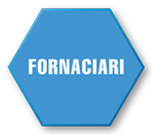Eco-Philosophy
Fornaciari supplies architectural coverings that improve the energy performance of any type of building. Ventilated facades combine several technical and physical principles to deliver a superior performance, providing countless benefits that traditional solutions are not able to deliver:
- Tax incentives for energy saving solutions: Fornaciari can also fit photovoltaic panels that integrate perfectly with ventilated facades, making a positive improvement in the building’s energy rating. This benefit also offers access to major tax incentives that cut down on the initial cost.
- Superior thermal comfort:A building is more comfortable for the people inside if the surface temperature of the interior walls is in line with the room temperature. The benefits offered by external insulation are twofold: in winter, the walls are able to store heat and maintain a higher internal temperature; the opposite effect occurs in the summer: the heat stored in the perimeter walls is reduced drastically, quashing the thermal wave caused by the sun’s rays.
- Insulation against noise: A ventilated façade increases the sound insulation capacity of internal walls. Comparing the Rw value of an exposed masonry structure with another wall clad in insulation, the latter offers 10-15 dB more sound insulation capacity. This is because the multiple layer system is capable of absorbing more sound and the presence of an uninterrupted infill eliminates acoustic bridges.
- Elimination of condensation: When two adjoining rooms, separated by a wall, have different internal temperatures and humidity, moisture tends to migrate towards the room with the lower pressure. Condensation will form if the actual pressure drops faster than the saturation pressure during this process. If insulation is fitted outside the partition wall, the pressure curves will never meet and so there is no risk of condensation forming. What’s more, humidity is eliminated as a result of the natural ventilation before it can deposit on the external façade or on the covering.
- Protection against the weather: The outer cladding of a ventilated façade protects the masonry wall from the effects of the weather, keeping it dry and preventing any risk of crumbling or infiltration. Most of the negligible percentage of incident water is actually lost in the cavity; whereas the tiny amount that reaches the external surface of the insulation dries readily due to the effect of the ventilation.
- Elimination of thermal bridges: A feature of many modern buildings is the use of different shapes and materials, which results in thermal bridges and creates an uneven distribution of the temperature, impeding thermal insulation and increasing the risk of condensation and mould. Seamless external insulation creates uniform thermal protection, whereas the outer covering blocks the sun’s rays: Their combined effect prevents thermal discontinuity, improving the energy performance of the building.
- Cost effective to fit: The metal support structure is light, modular and assembled completely dry, making the installation extremely fast and more cost effective than a traditional exterior insulation system.
- Low maintenance needs:the modular design of the substructure means individual slabs can be replaced if they are damaged.





